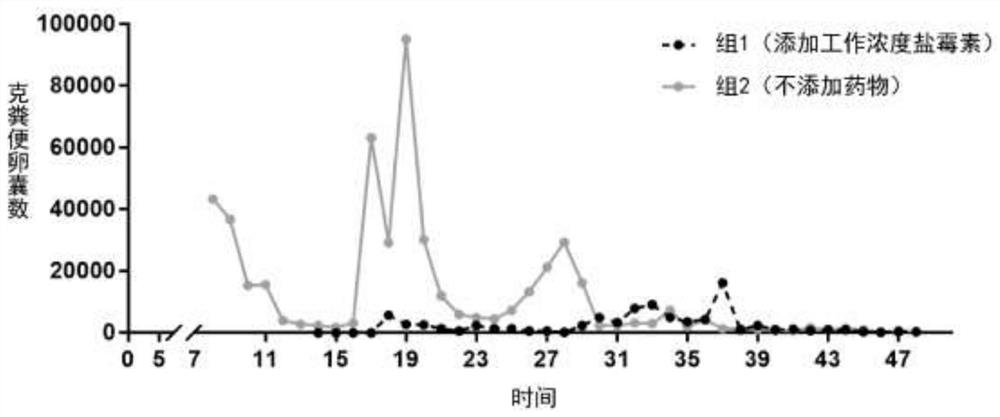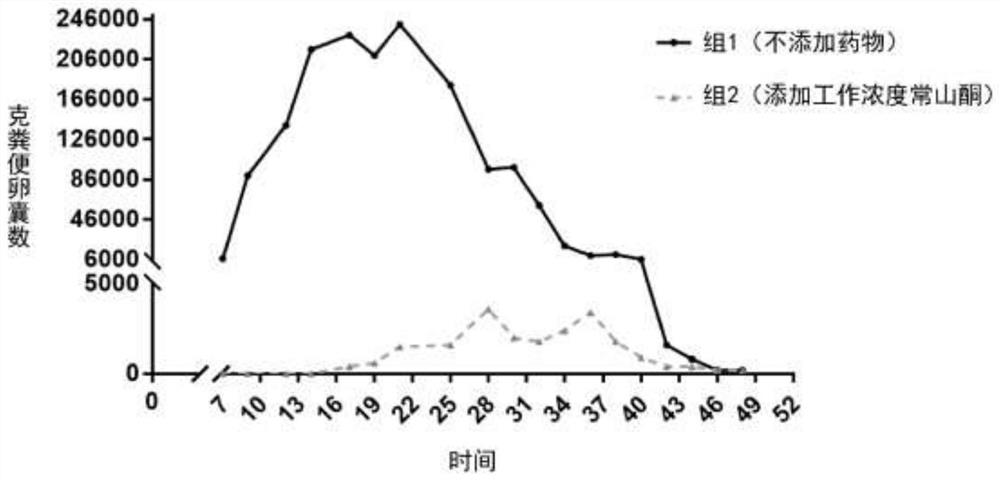Method for simulating rapid induction of anticoccidial drug-resistant strains in field and separation and identification method of anticoccidial drug-resistant strain
A technology of anticoccidiostats and identification methods, which is applied in the direction of microorganism-based methods, separation of microorganisms, biochemical equipment and methods, etc., can solve the problems of time-consuming, complex background of local strains, etc., and achieve short time-consuming, simple operation, Time-sensitive effect
- Summary
- Abstract
- Description
- Claims
- Application Information
AI Technical Summary
Problems solved by technology
Method used
Image
Examples
Embodiment 1
[0068] Embodiment 1 simulates the experimental scheme of rapidly inducing salinomycin-resistant strains in the field
[0069] The first batch of induced drug-resistant strain test
[0070] The first batch of experiments set up two groups, that is, the dosing group and the inoculation group. After cleaning and disinfection, they were covered with fresh litter (fresh rice chaff) that had been baked at high temperature and had no coccidia pollution, and equipped with drinking water, food intake, light, Ventilation, insulation and other related equipment. Breeders need to observe the temperature and humidity of the two test groups every day during the test, and improve the test conditions in time according to the data displayed by the temperature and humidity meter, and strictly prevent cross-contamination between groups during the test.
[0071] Introduce 300 1-day-old chicks, and give each chicken a wing number to facilitate the collation of the test results later. And on the ...
Embodiment 2
[0086] Example 2 Drug-resistant strain sample purification and identification
[0087] Oocyst expansion
[0088] Select 7-14 day-old AA broiler chicken coccidia without coccidia infection, orally inoculate chickens with sporulated oocysts, and add a higher dose concentration (3-4 times the working concentration) to the feed 48 hours before inoculation. ) of salinomycin, collect the oocysts in the feces excreted 6-10 days after inoculation.
[0089] Oocyst Purification
[0090] After 48 hours of sporulation, the oocysts were purified. Pour the potassium dichromate containing oocysts into a clean centrifuge tube, centrifuge at 3600rpm for 5min, pour off the upper liquid, resuspend the pellet with PBS, repeat 2-3 times; resuspend the pellet with saturated saline, centrifuge at 3600rpm for 5min , introduce the liquid containing oocysts in the upper layer into another clean centrifuge tube, add 5 times the volume of PBS, and centrifuge at 3600rpm for 5min; pour off the supernata...
Embodiment 3
[0105] Example 3 Simulating the Field Rapid Induction of Drug-resistant Strains Test Program to Obtain Phrysanthone-resistant Insect Strains
[0106] The experiment was divided into two groups. After cleaning and disinfection, they were covered with fresh bedding without coccidia pollution, and equipped with drinking water, feeding, lighting, ventilation, heat preservation and other related equipment. Breeders need to observe the temperature and humidity of the two test groups every day during the test, and improve the test conditions in time according to the data displayed by the temperature and humidity meter, and strictly prevent cross-contamination between groups during the test.
[0107] Introduce 200 1-day-old chicks, and on the day of introducing the coccidia-free chicks, give each chicken a wing number, so that the test records can be made in the later stage. In the dosing group, during the whole test period, a working concentration of the drug (3 mg / kg) was added to t...
PUM
 Login to View More
Login to View More Abstract
Description
Claims
Application Information
 Login to View More
Login to View More - R&D Engineer
- R&D Manager
- IP Professional
- Industry Leading Data Capabilities
- Powerful AI technology
- Patent DNA Extraction
Browse by: Latest US Patents, China's latest patents, Technical Efficacy Thesaurus, Application Domain, Technology Topic, Popular Technical Reports.
© 2024 PatSnap. All rights reserved.Legal|Privacy policy|Modern Slavery Act Transparency Statement|Sitemap|About US| Contact US: help@patsnap.com










